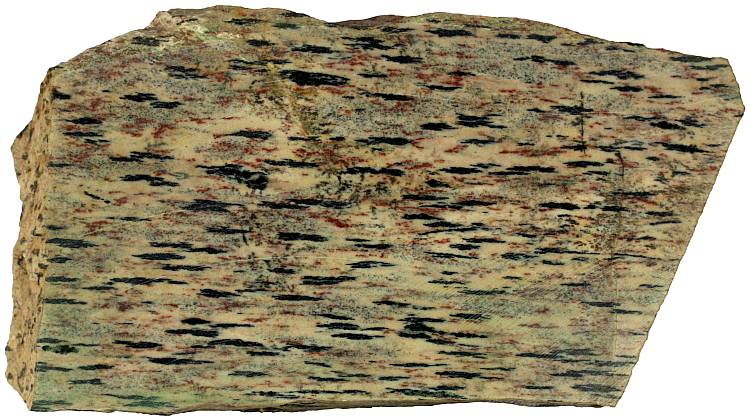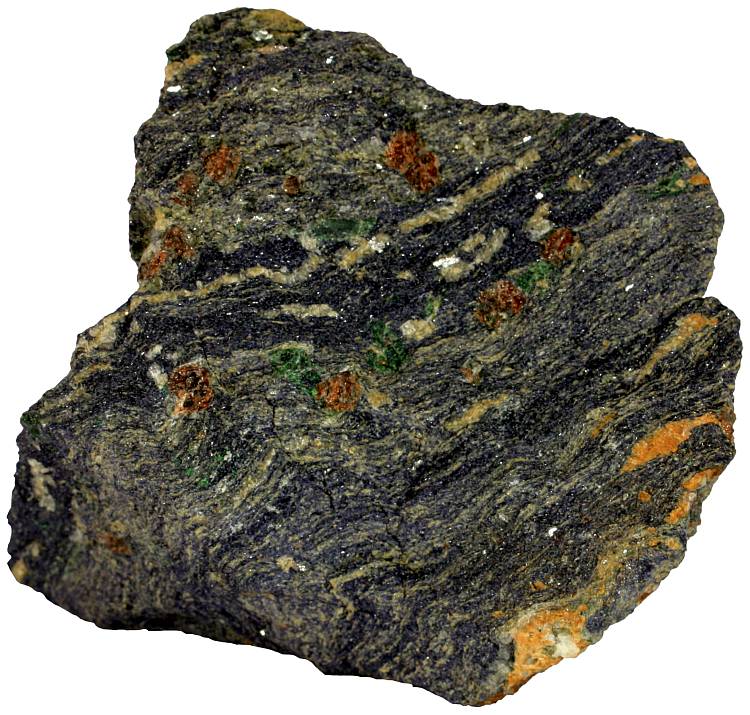Riebeckite is an amphibole group mineral. Amphiboles are hydrous silicate minerals. They are widespread in metamorphic and igneous rocks. Amphibole crystals are elongated because of their crystal structure which is composed of parallel silicate chains.
http://picasaweb.google.com/107509377372007544953/Rocks#5801027597794169954
Crystals in pegmatite (alkali feldspar granite according to the QAPF classification). Gray mineral is quartz. Colorado, USA. Width of sample 7 cm.
The most common amphibole mineral by far is hornblende. Riebeckite is a sodic amphibole (rich in Na). It forms a solid solution series with another sodic amphibole glaucophane. The chemical formula of the glaucophane-riebeckite pair:
Na2Mg3Al2Si8O22(OH)2 (glaucophane) — Na2Fe32+Fe23+Si8O22(OH)2 (riebeckite)
Both of them contain sodium, but magnesium and aluminum of glaucophane are replaced with iron in riebeckite which gives it much darker color. Both of them are bluish, but macroscopic riebeckite crystals are so dark that they are practically black. There is also a solid solution towards other less common sodium-bearing amphibole group minerals like arfvedsonite and richterite. Amphiboles are very complex minerals because of numerous replacements in their crystal structures. Their complexity is perhaps comparable to clay minerals only. The dividing line between them is an arbitrary 50% of Fe3+ content. The nomenclature used to be even more complicated because the composition between the two end-members (Fe3+ content between 30…70%) was referred to as crossite. This usage is obsolete since 20031.
Riebeckite commonly forms prismatic crystals, but it also occurs as a fibrous asbestiform mineral. Asbestiform variety is known as crocidolite or blue asbestos. This infamous variety of riebeckite used to have many applications, but it is no longer used in most countries. Crocidolite is considered to be one of the most hazardous of asbestiform minerals. The fibers of blue asbestos have greater tensile strength but lower heat resistance than chrysotile fibers2 which belong to the serpentine mineral group. Chrysotile is the most commonly used asbestiform mineral. Fibrous riebeckite which is partially replaced by quartz is known as tiger eye. It is widely used in lapidary work.
This mineral is found in alkali-rich igneous rocks such as alkali granite, syenite, nepheline syenite, and some acidic Na-rich volcanic rocks. Crocidolite occurs in metamorphosed iron formations. Glaucophane occurs in low-temperature, high-pressure metamorphic rocks (former basalt in subducting slabs).

Crystals in a metamorphic rock schist (riebeckite schist) from Germany. Width of sample 14 cm.
http://picasaweb.google.com/107509377372007544953/Coll#5779170714655278658
A sample of blue asbestos crocidolite (fibrous riebeckite) from South Africa showing the fibrous nature of the mineral. Width of sample 3 cm.

A glaucophane schist (blueschist). Glaucophane is lighter in color and blue color is therefore more noticeable. Green mineral is omphacite, red is garnet. These are the constituents of eclogite which is a closely related rock type to glaucophane schist. The Aosta Valley, Italy. Width of sample 6 cm.
References
1. Nesse, William D. (2011). Introduction to Mineralogy, 2nd Edition. Oxford University Press.
2. Deer, W. A., Howie, R. A. & Zussman, J. (1996). An Introduction to the Rock-Forming Minerals, 2nd Edition. Prentice Hall.
Leave a Reply